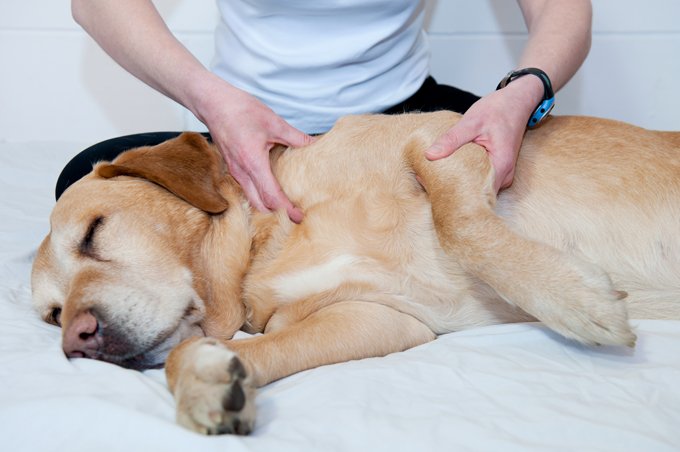If you’ve ever had a really good massage, you know how wonderful it is–and how much better you feel for hours or even days afterward. And you’ve probably already realized how much your dog loves a good ear- or tummy-rub. It’s no surprise, then, to realize that the benefits of massage just might apply to your dog, too. A good massage can
- increase circulation
- decrease muscle pain
- promote flexibility
- relieve stress
- improve autoimmune response (maybe)
… all of which is a good thing. And it’s a proven medical fact that massage lowers the level of stress hormones in the body. The positive effects on relaxation and energy are obvious, even if they’re still being measured.
And besides, massage feels great for dog and owner alike, and brings the two closer on a regular basis. What’s not to like?
How To Find A Massage Therapist
There are professional dog therapists in all major American cities, and you can find them in phone books or online directories; but a referral is your best source. Talk to friends or family who’ve tried pet massage, and ask your vet for a recommendation. When you find a therapist, ask for references as well as proof of training and experience. You’re literally putting your dog in this person’s hands, so you have a right to feel 100 percent comfortable with your choice.
When To Do It Yourself
You may not need to resort to a paid professional unless your dog has a serious health problem or you’re hoping for significant health benefits. There are a number of books and DVDs available that will give you complete instructions. You may find that your dog likes your technique just fine, as long as you’re careful and not overly eager.
What’s more, starting out with a little at-home massage is a great way to see if your dog will respond at all. Many really love it; others just never quite get used to the idea. It’s good to know what’s up with your own dog before you invest in professional attention.
How To Massage Your Dog
Dog massage involves the same techniques that are used on humans. There’s effleurage (long, slow strokes), friction (pressure without moving the skin) percussion (drumming with the fingers or hands), and petrissage (kneading). You can use all four on Fido. You can massage the entire body (with a few exceptions) or concentrate on special spots–or even on acupuncture points, if you’re familiar with them.
What To do:
- Have your dog lie down on a soft but firm surface–no pillows or cushions that may cause the dog to twist or bend in unexpected ways.
- Start with soft, slow strokes from head to tail.
- Scratch behind the ears, rub along the cheeks and under the chin, over the nose, between the eyes. Always use light pressure and small, circular strokes–nothing fast, hard, or abrupt.
- When you move to the neck, shoulders, and chest, it’s perfectly fine to gather small folds of loose skin for a gentle pinch. You can use three fingers on each side of the leg, too, rubbing softly in opposite directions. You can even give the paws a prolonged and gentle squeeze, if your dog is comfortable with having his or her feet handled (not all are).
- Walk your thumb and index finger down the length of the spine–not on the spine, but along the long muscles on each side.
- Squeeze the tail–don’t pull, but squeeze, gently and firmly, from base to tip.
- End with those long, slow strokes again.
- Throughout the massage, take your time. When your dog is ready for it to end–he’ll make it clear, usually by becoming restless or uncooperative–stop immediately.
What Not To Do:
- Don’t force it.
- Don’t wear out your welcome.
- Never massage a dog you don’t know well.
- Don’t pull or jerk a dog’s ears, tail, whiskers, or fur.
- Avoid pressing at all on the stomach; you could damage internal organs.
Bear in mind that not all dogs enjoy massage, so you need to pay close attention to your dog’s reactions as you proceed. Keep an eye out for these particular behaviors, all of which are telling you to stop now:
- Growling or snarling
- Flinching or yelping
- Even the slightest nip
- Flattened ears, twitching eyebrows
- Tensing or holding of breath
- Sidelong looks, rolling eyes
Remember, this is supposed to be enjoyable for everyone involved. If your dog isn’t having a good time, what’s the point? And don’t forget: keep it light and gentle. Serious, deep massage should only be done by a trained and certified practitioner whom you trust.
If all goes well–and it probably will–you may find you’ve put your dog right to sleep by the end of the session. And that’s a good thing. (You might even want to join in. See? Now everybody’s relaxed.)









